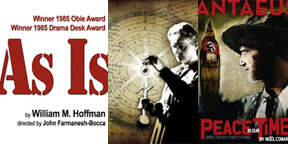SHORT TAKES ON CURRENT LOS ANGELES THEATER
AS IT WAS: As Is, written by William M. Hoffman in 1984, when so many of our contemporaries were dying of the AIDS epidemic, still maintains its power. If it is dated at all, it is dated in good ways: it means that our so-called “gay” theater has grown subtler and more nuanced with the passing years. 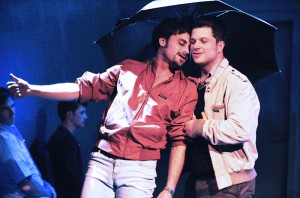 The New American Theatre revival profits from the snap of John Farmanesh-Bocca’s directorial choices and by the fact that its two central characters – a former gay couple who forge a new kind of relationship when one of them discovers he has AIDS – are played by Mark Shunock and Charles Pasternak, who grow richer and deeper as the play progresses until they wring every possible emotion out of the play’s penultimate scene. But the production itself seems somewhat makeshift, and
The New American Theatre revival profits from the snap of John Farmanesh-Bocca’s directorial choices and by the fact that its two central characters – a former gay couple who forge a new kind of relationship when one of them discovers he has AIDS – are played by Mark Shunock and Charles Pasternak, who grow richer and deeper as the play progresses until they wring every possible emotion out of the play’s penultimate scene. But the production itself seems somewhat makeshift, and 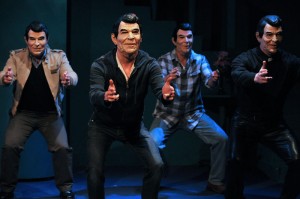 the cast (with the exception of the two leads and the excellent Roy Abramson and the tart Vanessa Waters) is not always up to professional standards. But there is a chorus of Ronald Reagans that livens up the proceedings mightily: it is encouraging to be reminded that some of the blame for the epidemic sits squarely on the shoulders of the former president.
the cast (with the exception of the two leads and the excellent Roy Abramson and the tart Vanessa Waters) is not always up to professional standards. But there is a chorus of Ronald Reagans that livens up the proceedings mightily: it is encouraging to be reminded that some of the blame for the epidemic sits squarely on the shoulders of the former president.
 CURIE-OSITY: Radiance: The Passion of Marie Curie, one of the handsomest productions this reviewer has ever seen at the Geffen, is the epitome of elegant simplicity, from Daniel Sullivan’s assured direction to Thomas Lynch’s lovely set to John Boesche’s evocative projections to Rita Ryack’s lived-in period costumes to the cast which speaks clearly and crisply and manages to bring some flesh to what are often stick figures. The problem is the play which, well-intentioned and passionate though it may be, seems,
CURIE-OSITY: Radiance: The Passion of Marie Curie, one of the handsomest productions this reviewer has ever seen at the Geffen, is the epitome of elegant simplicity, from Daniel Sullivan’s assured direction to Thomas Lynch’s lovely set to John Boesche’s evocative projections to Rita Ryack’s lived-in period costumes to the cast which speaks clearly and crisply and manages to bring some flesh to what are often stick figures. The problem is the play which, well-intentioned and passionate though it may be, seems,  in the first act, a compendium of biofilm clichés that serve to remind those who remember that the badly dated and sentimental MGM version was even more detailed on a historical level. The second act, lighter in style and more human, dares to go where the reverential film didn’t dare to go: into the heart of a love affair between Marie Curie (the splendid Anna Gunn) and her married cohort, Paul Langevin (the fine Dan Donohue). Unfortunately, though it may be dealing with matters of truth, this second act plays like melodrama, as if its story was stitched together from shards of Flaubert, Tolstoy, and Balzac. Radiance has been given a good showcase; but would so much good work have been lavished on the play were it not written by Alan Alda?
in the first act, a compendium of biofilm clichés that serve to remind those who remember that the badly dated and sentimental MGM version was even more detailed on a historical level. The second act, lighter in style and more human, dares to go where the reverential film didn’t dare to go: into the heart of a love affair between Marie Curie (the splendid Anna Gunn) and her married cohort, Paul Langevin (the fine Dan Donohue). Unfortunately, though it may be dealing with matters of truth, this second act plays like melodrama, as if its story was stitched together from shards of Flaubert, Tolstoy, and Balzac. Radiance has been given a good showcase; but would so much good work have been lavished on the play were it not written by Alan Alda?
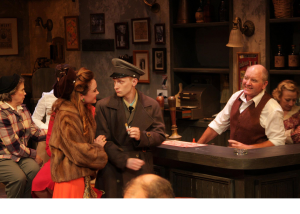 COWARDICE: There is much to admire and respect and even enjoy in the Antaeus Company production of Noël Coward’s Peace in Our Time (Epps Cast*), but a serious question nags at me: Why do it at all? Since forty pages and twelve characters have been cut from the play, are we really seeing the play as it was intended to be seen? Why was it a failure? Can we know that this – given that what we are experiencing is seriously pared-down – is the sum of Coward’s play? Does adding a host of lesser-known Coward songs give it stature, since they may be “lesser-known” for good reason? Oh, there are a couple of patter songs that have the old Coward zing, but “London Pride” hardly does
COWARDICE: There is much to admire and respect and even enjoy in the Antaeus Company production of Noël Coward’s Peace in Our Time (Epps Cast*), but a serious question nags at me: Why do it at all? Since forty pages and twelve characters have been cut from the play, are we really seeing the play as it was intended to be seen? Why was it a failure? Can we know that this – given that what we are experiencing is seriously pared-down – is the sum of Coward’s play? Does adding a host of lesser-known Coward songs give it stature, since they may be “lesser-known” for good reason? Oh, there are a couple of patter songs that have the old Coward zing, but “London Pride” hardly does 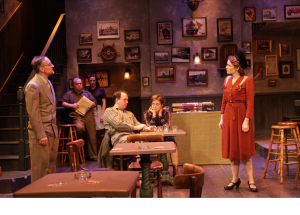 for this play what “Twentieth Century Blues” did for Coward’s Cavalcade. Its premise – what if London was occupied by Nazi Germany during World War II? – is not dissimilar from two novels, Sinclair Lewis’s It Can’t Happen Here (which was infinitely wittier and more prescient) and Philip Roth’s The Plot Against America (which was more heartfelt and intense), that are readily available. And Coward himself, during this period, wrote the heartbreaking study of a working-class family, This Happy Breed, and a patriotic but stunning film, In Which We Serve, which tied him directly to the horrors of the London blitz and the efforts of real people to deal with it.
for this play what “Twentieth Century Blues” did for Coward’s Cavalcade. Its premise – what if London was occupied by Nazi Germany during World War II? – is not dissimilar from two novels, Sinclair Lewis’s It Can’t Happen Here (which was infinitely wittier and more prescient) and Philip Roth’s The Plot Against America (which was more heartfelt and intense), that are readily available. And Coward himself, during this period, wrote the heartbreaking study of a working-class family, This Happy Breed, and a patriotic but stunning film, In Which We Serve, which tied him directly to the horrors of the London blitz and the efforts of real people to deal with it. 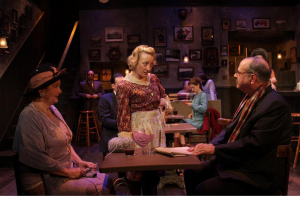 There, having got that off my chest, I can say that, to the degree that it works at all, Barry Creyton has apparently done a solid job of adapting it, and Casey Stangl has nicely directed it so that it keeps moving despite its length. And though there is not one member of the cast who destroys the effectiveness of the ensemble, there are a few performances that seem sub-par. I did think that JD Cullum is marvelous as a snooty homosexual with a penchant for young Nazi officers and that Zoe Perry, as a young woman in constant conflict with her husband, is wonderfully natural; these, however, are supporting performances. I also thought that Steve Hofvendahl, Lily
There, having got that off my chest, I can say that, to the degree that it works at all, Barry Creyton has apparently done a solid job of adapting it, and Casey Stangl has nicely directed it so that it keeps moving despite its length. And though there is not one member of the cast who destroys the effectiveness of the ensemble, there are a few performances that seem sub-par. I did think that JD Cullum is marvelous as a snooty homosexual with a penchant for young Nazi officers and that Zoe Perry, as a young woman in constant conflict with her husband, is wonderfully natural; these, however, are supporting performances. I also thought that Steve Hofvendahl, Lily 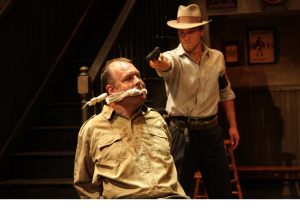 Knight, Danielle K. Jones, and Jason Dechert make a believably stalwart family unit. And, as the evening wore on, I grew fonder and fonder of the Graingers as people; it must be due to the fact that the actors playing them, John Combs and Amelia White, are quite good. But, lovely as Tom Budewitz’s recreation of a London pub may be, I felt less as if I were in a pub and more that I was in a theater. And I had the uneasy feeling throughout that a kind of smugness infected this production, as if the company was congratulating itself on the fine work they had done by unearthing a play by Coward that we may not have known even existed. It made one feel reprimanded for not cheering.
Knight, Danielle K. Jones, and Jason Dechert make a believably stalwart family unit. And, as the evening wore on, I grew fonder and fonder of the Graingers as people; it must be due to the fact that the actors playing them, John Combs and Amelia White, are quite good. But, lovely as Tom Budewitz’s recreation of a London pub may be, I felt less as if I were in a pub and more that I was in a theater. And I had the uneasy feeling throughout that a kind of smugness infected this production, as if the company was congratulating itself on the fine work they had done by unearthing a play by Coward that we may not have known even existed. It made one feel reprimanded for not cheering.
As Is
The New American Theatre at the McCadden Place Theatre
photos by Daniel G. Lam
scheduled to end on December 18
for tickets, visit http://www.newamericantheatre.com/
Radiance: The Passion of Marie Curie
The Geffen Playhouse
photos by photos by Michael Lamont
scheduled to end on December 18
for tickets, visit http://geffenplayhouse.com/
Peace in Our Time (Epps Cast*)
The Antaeus Company at Deaf West Theater
photos by Geoffrey Wade
scheduled to end on December 18
for tickets, visit http://www.antaeus.org/
*[Editors note: The Antaeus Company always uses two entirely different casts who alternate on various nights, assigning each cast a name in order to differentiate; the cast Mr. Perr reviewed is dubbed the Epps Cast; the other one is called the Stubbs Cast]
